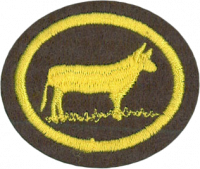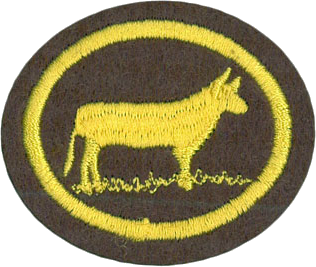Difference between revisions of "AY Honors/Cattle Husbandry/Answer Key/es"
From Pathfinder Wiki
< AY Honors | Cattle HusbandryAY Honors/Cattle Husbandry/Answer Key/es
(Created page with "</noinclude> <!-- 1. Nombrar al menos 25 partes de un buey. -->") |
(Updating to match new version of source page) |
||
| (31 intermediate revisions by 2 users not shown) | |||
| Line 1: | Line 1: | ||
| − | + | {{HonorSubpage}} | |
| − | |||
| − | {{ | ||
| − | |||
| − | |||
| − | |||
| − | |||
| − | |||
| − | |||
| − | |||
| − | }} | ||
| − | |||
| − | |||
<section begin="Body" /> | <section begin="Body" /> | ||
{{ansreq|page={{#titleparts:{{PAGENAME}}|2|1}}|num=1}} | {{ansreq|page={{#titleparts:{{PAGENAME}}|2|1}}|num=1}} | ||
| Line 21: | Line 9: | ||
{{ansreq|page={{#titleparts:{{PAGENAME}}|2|1}}|num=2}} | {{ansreq|page={{#titleparts:{{PAGENAME}}|2|1}}|num=2}} | ||
<noinclude></noinclude> | <noinclude></noinclude> | ||
| − | <!-- 2. | + | <!-- 2. ¿Cuáles son las cuatro características de una buena novilla? --> |
| + | |||
| + | {{clear}} | ||
| − | |||
| − | + | {{clear}} | |
| − | + | {{clear}} | |
| − | + | {{clear}} | |
| − | + | {{clear}} | |
| − | + | {{clear}} | |
| − | + | {{clear}} | |
<noinclude></noinclude> | <noinclude></noinclude> | ||
| Line 41: | Line 30: | ||
{{ansreq|page={{#titleparts:{{PAGENAME}}|2|1}}|num=3}} | {{ansreq|page={{#titleparts:{{PAGENAME}}|2|1}}|num=3}} | ||
<noinclude></noinclude> | <noinclude></noinclude> | ||
| − | <!-- 3. | + | <!-- 3. ¿Qué es la castración? ¿Cuál es su propósito? --> |
| − | |||
| − | + | {{clear}} | |
| − | |||
| − | |||
| − | |||
| − | |||
| − | |||
<noinclude></noinclude> | <noinclude></noinclude> | ||
| Line 55: | Line 38: | ||
{{ansreq|page={{#titleparts:{{PAGENAME}}|2|1}}|num=4}} | {{ansreq|page={{#titleparts:{{PAGENAME}}|2|1}}|num=4}} | ||
<noinclude></noinclude> | <noinclude></noinclude> | ||
| − | <!-- 4. | + | <!-- 4. ¿Por qué se descuerna? ¿Qué edad es mejor para el descuerne? --> |
| − | |||
<noinclude></noinclude> | <noinclude></noinclude> | ||
| Line 62: | Line 44: | ||
{{ansreq|page={{#titleparts:{{PAGENAME}}|2|1}}|num=5}} | {{ansreq|page={{#titleparts:{{PAGENAME}}|2|1}}|num=5}} | ||
<noinclude></noinclude> | <noinclude></noinclude> | ||
| − | <!-- 5. | + | <!-- 5. ¿Qué es una máquina de alimentación? --> |
| − | |||
| − | + | {{clear}} | |
<noinclude></noinclude> | <noinclude></noinclude> | ||
| Line 71: | Line 52: | ||
{{ansreq|page={{#titleparts:{{PAGENAME}}|2|1}}|num=6}} | {{ansreq|page={{#titleparts:{{PAGENAME}}|2|1}}|num=6}} | ||
<noinclude></noinclude> | <noinclude></noinclude> | ||
| − | <!-- 6. | + | <!-- 6. ¿Cuándo es un ternero destetado? --> |
| − | |||
<noinclude></noinclude> | <noinclude></noinclude> | ||
| Line 78: | Line 58: | ||
{{ansreq|page={{#titleparts:{{PAGENAME}}|2|1}}|num=7}} | {{ansreq|page={{#titleparts:{{PAGENAME}}|2|1}}|num=7}} | ||
<noinclude></noinclude> | <noinclude></noinclude> | ||
| − | <!-- 7. | + | <!-- 7. ¿Cuáles son las necesidades de vivienda de ganado? --> |
| − | |||
<noinclude></noinclude> | <noinclude></noinclude> | ||
| Line 85: | Line 64: | ||
{{ansreq|page={{#titleparts:{{PAGENAME}}|2|1}}|num=8}} | {{ansreq|page={{#titleparts:{{PAGENAME}}|2|1}}|num=8}} | ||
<noinclude></noinclude> | <noinclude></noinclude> | ||
| − | <!-- 8. | + | <!-- 8. ¿Por qué es mejor poner la comida y el agua en los extremos opuestos del corral? --> |
| − | + | {{clear}} | |
<noinclude></noinclude> | <noinclude></noinclude> | ||
| Line 93: | Line 72: | ||
{{ansreq|page={{#titleparts:{{PAGENAME}}|2|1}}|num=9}} | {{ansreq|page={{#titleparts:{{PAGENAME}}|2|1}}|num=9}} | ||
<noinclude></noinclude> | <noinclude></noinclude> | ||
| − | <!-- 9. | + | <!-- 9. Identificar en persona o a partir de fotografías tres razas de ganado vacuno y tres de las razas de ganado lechero. --> |
| − | + | {{:AY Honor/Beef cattle breeds/es}} | |
| − | |||
| − | {{: | ||
| − | + | {{clear}} | |
| − | |||
| − | {{: | + | {{:AY Honor/Dairy cattle breeds/es}} |
<noinclude></noinclude> | <noinclude></noinclude> | ||
| Line 107: | Line 83: | ||
{{ansreq|page={{#titleparts:{{PAGENAME}}|2|1}}|num=10}} | {{ansreq|page={{#titleparts:{{PAGENAME}}|2|1}}|num=10}} | ||
<noinclude></noinclude> | <noinclude></noinclude> | ||
| − | <!-- 10. | + | <!-- 10. ¿Qué tipo de alimentación se requiere durante los siguientes tiempos? --> |
<noinclude></noinclude> | <noinclude></noinclude> | ||
{{ansreq|page={{#titleparts:{{PAGENAME}}|2|1}}|num=10a}} <!--T:23--> | {{ansreq|page={{#titleparts:{{PAGENAME}}|2|1}}|num=10a}} <!--T:23--> | ||
<noinclude></noinclude> | <noinclude></noinclude> | ||
| − | |||
<noinclude></noinclude> | <noinclude></noinclude> | ||
| Line 119: | Line 94: | ||
<noinclude></noinclude> | <noinclude></noinclude> | ||
| − | + | {{clear}} | |
<noinclude></noinclude> | <noinclude></noinclude> | ||
| Line 126: | Line 101: | ||
<noinclude></noinclude> | <noinclude></noinclude> | ||
| − | + | {{clear}} | |
<noinclude></noinclude> | <noinclude></noinclude> | ||
| Line 133: | Line 108: | ||
{{ansreq|page={{#titleparts:{{PAGENAME}}|2|1}}|num=11}} | {{ansreq|page={{#titleparts:{{PAGENAME}}|2|1}}|num=11}} | ||
<noinclude></noinclude> | <noinclude></noinclude> | ||
| − | <!-- 11. | + | <!-- 11. ¿Cómo puede una novilla ser entrenada para convertirse en una apacible vaca? --> |
| − | + | {{clear}} | |
<noinclude></noinclude> | <noinclude></noinclude> | ||
| Line 141: | Line 116: | ||
{{ansreq|page={{#titleparts:{{PAGENAME}}|2|1}}|num=12}} | {{ansreq|page={{#titleparts:{{PAGENAME}}|2|1}}|num=12}} | ||
<noinclude></noinclude> | <noinclude></noinclude> | ||
| − | <!-- 12. | + | <!-- 12. Cuidar de uno o más terneros por un período de seis meses. --> |
| − | + | {{clear}} | |
<noinclude></noinclude> | <noinclude></noinclude> | ||
{{CloseReq}} <!-- 12 --> | {{CloseReq}} <!-- 12 --> | ||
<noinclude></noinclude> | <noinclude></noinclude> | ||
| − | == | + | ==Referencias== |
| − | |||
<noinclude></noinclude> | <noinclude></noinclude> | ||
| − | + | {{CloseHonorPage}} | |
| − | |||
Latest revision as of 19:29, 13 July 2022
1
Nombrar al menos 25 partes de un buey.
2
¿Cuáles son las cuatro características de una buena novilla?
3
¿Qué es la castración? ¿Cuál es su propósito?
4
¿Por qué se descuerna? ¿Qué edad es mejor para el descuerne?
5
¿Qué es una máquina de alimentación?
6
¿Cuándo es un ternero destetado?
7
¿Cuáles son las necesidades de vivienda de ganado?
8
¿Por qué es mejor poner la comida y el agua en los extremos opuestos del corral?
9
Identificar en persona o a partir de fotografías tres razas de ganado vacuno y tres de las razas de ganado lechero.
10
¿Qué tipo de alimentación se requiere durante los siguientes tiempos?
10a
Primeros 90 días
10b
De 90 a 180 días
10c
De 180 días hacia la venta
11
¿Cómo puede una novilla ser entrenada para convertirse en una apacible vaca?
12
Cuidar de uno o más terneros por un período de seis meses.


